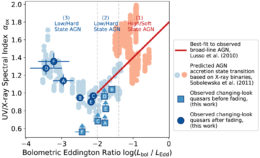Black holes come in a variety of sizes — from a mass of a few Suns, to millions or even billions of solar masses. As these vastly different black holes feast on accreting matter, do they behave in the same way?
Shining Structures

An example model in cross-section of the possible geometry of an accreting black hole before and after a state transition. The two emitting components are the hot coronal gas enveloping the black hole and the thin accretion disk that lies at its midplane. [Adapted from Ruan et al. 2019]
Feasting black holes don’t always maintain the same geometry, though! Black holes transition between different states over time — each with its own physical geometry and spectrum shape. We think that these accretion state transitions are related to changes in the amount of gas a black hole consumes, but there’s still a lot left to learn about this process.

Illustrations of two types of accreting black holes: a stellar-mass black hole accreting from a binary companion (top) and a supermassive black hole accreting gas in a galaxy’s center (bottom). [Top: ESA/NASA/Felix Mirabel; Bottom: ESO/M. Kornmesser]
It’s a Matter of Scale
One major question is whether the geometry of an accreting black hole behaves the same way through state transitions regardless of the black hole’s size. We observe accreting black holes on two dramatically different scales: black holes of 5–15 solar masses that consume material from a companion star, and supermassive black holes feeding on material from the gas-rich environment at the centers of galaxies.
Do the geometries of stellar-mass black holes directly scale up to supermassive ones?
An Alternative to Waiting
The simplest way to answer this question would be to compare the spectra of stellar-mass and supermassive black holes before and after a state transition, to see if the spectra evolve in the same way. But though state transitions take place on timescales of days for stellar-mass black holes, they take 10,000–100,000 years for supermassive black holes — far too long to observe.

This plot shows spectral behavior of accreting black holes over a range of relative brightnesses. The predicted values for supermassive black holes (faint orange and blue data points), which are based on observations of state transitions in stellar-mass black holes, are well matched to the observed behavior of the sample of accreting supermassive black holes (solid red line and blue data points). Click to enlarge. [Ruan et al. 2019]
Same Structures, Different Sizes
From their sample — which, critically, includes a set of very faint accreting supermassive black holes called changing-look quasars to represent the low end of the luminosity scale — Ruan and collaborators find that supermassive black holes do exhibit the expected spectral features based on predictions from stellar-mass black holes.
What does this mean? The structures of accreting black holes seem to directly scale across eight orders of magnitude in mass and across different accretion states. If true, this has the pretty awesome implication that we can use the observable, short-timescale transitions in nearby, stellar-mass black holes to model the long-timescale behavior of feeding supermassive black holes in the distant universe.
Citation
“The Analogous Structure of Accretion Flows in Supermassive and Stellar Mass Black Holes: New Insights from Faded Changing-look Quasars,” John J. Ruan et al 2019 ApJ 883 76. doi:10.3847/1538-4357/ab3c1a

4 Comments
Pingback: Comparando agujeros negros pequeños y grandes – Observatori Astronòmic
Pingback: Comparando agujeros negros pequeños y grandes « SEDA / LIADA - RedLIADA - Cursos LIADA - Cielo del Mes - Fenómenos Astronómicos - RELEA
Pingback: Comparando agujeros negros pequeños y grandes « Sección de Astrofísica de la LIADA
Pingback: Febrero 2020 – Observatori Astronòmic